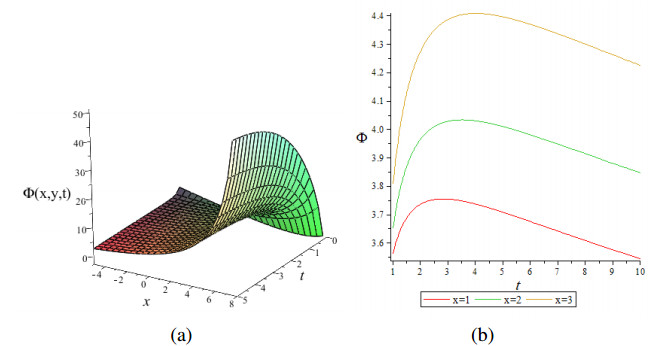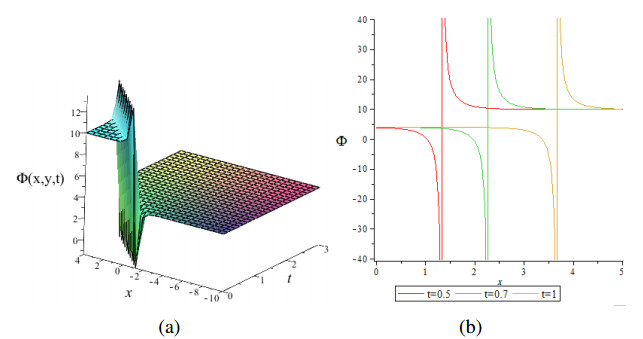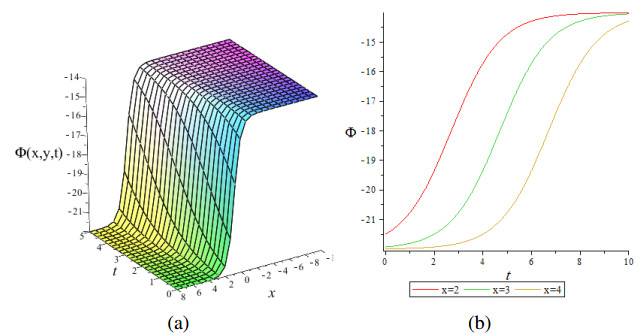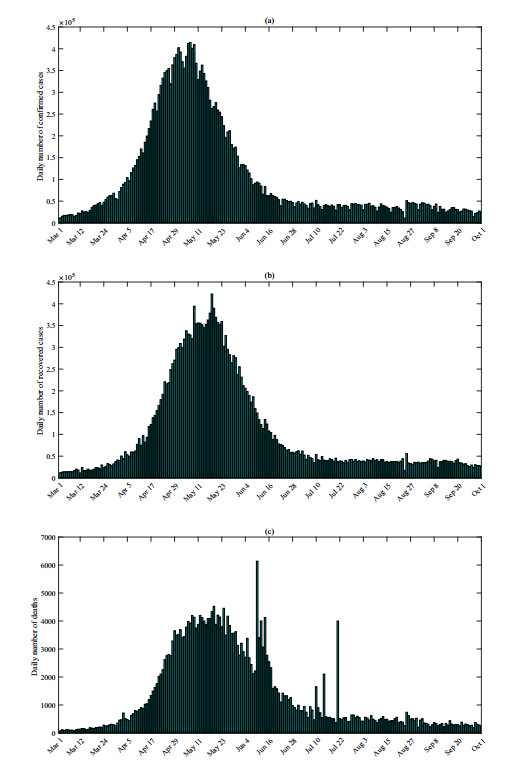1.
Introduction
1.1. Overview
Many physical phenomena, in the fields of sound and electrical waves, heat transfer, mechanics, and optics can be described through partial differential equations. Therefore, we can say that the study of mathematical physics depends primarily on the study of partial differential equations. During previous decades, many methods were developed to reduce and solve partial differential equations, including Symmetry method [1,2,3,4], scattering transformation [5], Tanh method [6], the homogeneous balance method [7], Aboodh transform decomposition method [8], (G′/G, 1/G)-expansion method [9], Exp-function method [10], Generalized He's Exp-function method [11], Kudryashov method [12], and Generalized Kudryashov method [13]. Consider the nonlinear (2+1)-dimensional Date-Jimbo-Kashiwara-Miwa (DJKM) equation [14,15] in the following form:
where Φ=Φ(x,y,t). DJKM describes the wave diffusion of physical-quantity, and it has certain applications in plasma physics [16,17]. This equation was presented by Jimbo and Miwa as second formulas for Kadomtsev-Petviashvili hierarchy.
1.2. Related literatures
There is a wealth of literature related to this governing equation such as: Bibi and Ahmad [14] who employed the symmetry method to reduce the governing equation to another equation of lower order and obtained its exact solutions. The exp(−ϕ(ξ))-Expansion Method was utilized by Sajid and Akram [14] for obtaining traveling wave solutions for Eq (1). Halder et al. [18] used the Lie symmetry analysis and singularity method to study one type of the governing equation. Wazwaz [19] studied the integrability of this equation and obtained multiple soliton solutions by using Painlevé analysis and Hirota's method. Akram et al. [16] applied the extended direct algebraic method to obtain exact solutions for the governing equation.
1.3. Main idea
The previous literature led us to determine the study of the governing equation to apply the Lie symmetry method and the Generalized Kudryashov method. Our main objective of this paper is to convert the governing equation to several distinct ordinary differential equations (ODE). We then solve the resulting ODEs to obtain exact and novel wave solutions for the governing equation. As a result, we can show the dynamic behavior of wave solutions in 2-D and 3-D plots.
2.
Lie symmetry method
In this part, the Lie symmetry method [20,21,22] is used to deduce the similarity reductions for the governing equation, so the one-parameter Lie symmetry of infinitesimal variables is shown as follows:
where ε is the one parameter Lie group, A,B,C and E are infinitesimal variables and t,x and y are independent variables of the function Φ.
The vector generator χ is related to the above-mentioned group transformations which can be written as the following expression:
when the following invariance condition is satisfied:
where Δ represents Eq (1) and Γ(3) is the third order prolongation[23,24] of the operator V
where the components E[x],E[xx],E[xyy],E[y],E[xy].... can be determined from the following expressions:
Substituting (1) into Eq (4), yields an identity components Ax,Axx,Bt,Bx,.... and adding the coefficients of Φx,x,t, Φy,y,y, ... and equating them to zero, then the infinitesimals A,B,C and E are obtained from the following equations:
solving the system of Eq (7), we get
The vector field operator V of Eq (8) can be presented as
where
The Lie-bracket [Vi,Vj]=ViVj−VjVi is used for obtaining the commutator relations which are shown in Table 1, where
3.
Reductions and closed form solutions
To obtain new independent variables, we utilize the characteristic equation as follows:
Case I. Using V1 where g1(t)=t2, Eq (12) takes the following form:
The similarity solution of Eq (1) takes the form
where ζ=x√t,η=yt. Substituting Φ in Eq (1) we get
The ordinary differential equations of Eq (15) take the following experssion:
where θ=kζ+hη.
To obtain the exact solution for Eq (16), we utilize generalized Kudryashov method (GKM) [11], given as follows:
where ϕ(θ) is the solution for the following Ricati equation ϕ′(θ)=A+Bϕ(θ)+Cϕ2(θ). For simplicity, we take i=1 and substitute Eq (17) into Eq (16) then to obtain
Substituting Eq (18) into Eqs (14) and (17), the exact solutions of Eq (1) can be expressed as
Set 1. A≠0,B≠0,C≠0.
where θ=kx√t+√4AC−B2k2yt.
Set 2. A=−12,B=0,C=−12.
where θ=kx√t+2k2yt.
Case II. Substituting V1 in Eq (12) where g1(t)=t, then Eq (12) is expressed as follows:
Then the invariants are presented by ζ=xt14,η=yt12 and Φ(t,x,y)=1t14F(ζ,η). Further Eq (1) is reduced to the following form:
For reducing Eq (22) to ODE we have two subcases:
Subcase (a). Using the scaling transformation in Eq (22)
Substituting from Eq (23) into Eq (22) we have 2ϵ1=ϵ2=−2ϵ.
The characteristic is given as
The invariant variables can be written as
The ODE of Eq (22) is provided by
To obtain the exact solutions of Eq (26), we suppose that the solution of Eq (26) has the form
For simplicity, we take j=2, substitute Eq (27) into Eq (26), then the closed form solution of Eq (1) takes the expression
where A0 and A1 are arbitrary constant.
Subcase (b). Utilizing symmetry method for Eq (22), we obtained the infinitesimals of Eq (22) as follows:
The vector field of Eq (22) can take the form
where
Using χ2+wχ3, the characteristic equation is yielded
The similarity solution for Eq (22) takes the form
The reduced ODE can take the expression
Utilizing GKM in the previous case, the closed-form solution of Eq (34) is shown as
Substituting Eq (35) into Eq (34), collecting the coefficients of derivative ϕ(θ) and solving the algebraic equations, we obtain the values of A0 and A1
Set 1. A≠0,B≠0,C≠0.
where A1=−2(A+C−B)(4AC−B2)14,θ=y√t+1(4AC−B2)14xt14.
Set 2. A=12,B=0,C=12.
where A1=−12,θ=y√t+xt14.
Cases III. Using wV2,V3,V4 where g2(t),g3(t),g4(t) are constants, we get
Using Eq (39), we obtain the invariant solutions
Substituting Eq (40) into Eq (1) we get
Utilizing transformation θ=kζ+hη, Eq (41) is reduced to the next equation
The exact solutions of Eq (42) can be deduced by applying GKM in the previous method. Substituting Eq (17) into Eq (42) at i=1 and collecting the coefficient of derivative ϕ(θ), then equating this equations to zero, this equations is solved and the values of A0,A1,w,h and k are obtained as
The closed-form solutions of Eq (1) can be expressed as
Set 1. A≠0,B≠0,C=0.
where k=12(4−w3−h2wB2),θ=kt+h(x−wy).
Set 2. A=0,B≠0,C≠0.
where k=12(4−w3−h2wB2),θ=kt+h(x−wy).
Cases IV. Utilizing wV2,V3, where α2(t),α3(t) are constant, we obtain
Using Eq (46), we obtain the invariant solutions
Substituting Eq (47) into Eq (1) we get
Taking the transformation θ=kζ+hη, Eq (48) is reduced to the form
The coveted exact solution of Eq (49) is given. Hence, by using Eq (17) in Eq (49), the solution for Eq (1) is provided as
Set 1. A≠0,B≠0,C≠0.
where k=12(4h2wAC+4−w3−h2wB2),θ=kt+h(x−wy).
Set 2. A=12,B=0,C=−12.
where k=12(−h2w+4−w3),θ=kt+h(x−wy).
4.
Results & discussion
In this section, we explain the dynamic behavior of the obtained solutions in Eqs (19), (20), (28), (37), (38), (44), (45) and compare these results with previous literatures.
The physical behavior of the solutions is illustrated in three-dimensional and two-dimensional forms. The solutions include trigonometric functions, hyperbolic functions, and expansion functions. The Maple software was used to review the solutions as follows:
In Figure 1, presents wave solution of Eq (19) in 3-D and 2-D shapes with perfect numerical values of A0=5,k=0.1,A=3,C=2,B=−1 at y = 1.
In Figure 2, the solution of Eq (28) shows the behavior of a single wave and it is presented through 3-D and 2-D graphs. The constants are chosen as follows: A0=1,A2=1,k=0.1,A=3,C=2,B=3 when y=1.
Figure 3 shows doubly soliton of Eq (37) in 3-D and 2-D shapes with perfect choice for values of A0=0,A1=1.
Figure 4 depicts the view anti-kink wave solution of Eq (44) in 3-D and 2-D graphs with a suitable choice of values A0=3,w=−1,h=−3,A=2,C=0,B=1 with y=1.
In Figure 5, the solution of Eq (45) represents a kink wave solution in 3-D and 2-D plots with perfect simulation of the values A0=1,h=2,w=1,z=1,A=0,C=−3,B=1 at y=1.
The authors in [13] used the symmetry method and obtained a subcase from our infinitesimals. Then, they reduced the governing equation to one reduction case, but we obtained five reduction cases.
The authors in [14] used two different traveling wave methods to obtain exact solutions. However, they reduced the governing equation through an algebraic transformation. When comparing these solutions with our obtained solutions, it turned out that our solutions are novel solutions and show different physical behavior from other solutions.
5.
Conclusions
In this paper, we applied the Lie symmetry method to obtain infinitesimals and vector fields. This led to reduce the governing equation to a new form of partial differential equations (PDEs). Then, by utilizing the symmetry method again and similarity transformation: the new form of PDEs has been converted instead of reduced to five different ODEs. The general exact wave solutions are obtained by using GKM. These solutions are represented in 2-D and 3-D graphs to show the physical properties of the solutions.
Use of AI tools declaration
The authors declare that they have not used Artificial Intelligence (AI) tools in the creation of this article.
Acknowledgment
The author (A. A. Gaber) would like to thank the Deanship of Scientific Research of Majmaah University for supporting this work under Project Number (R-2024-947).
Conflict of interest
The authors declare no conflicts of interest.









 DownLoad:
DownLoad:






















